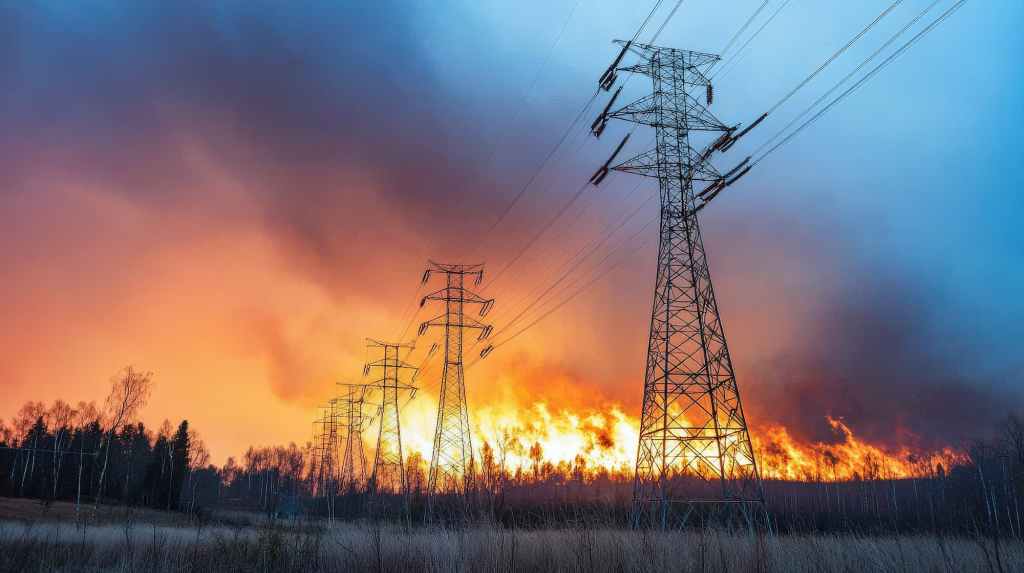Abraham Lincoln’s adage that “you can’t fool all of the people all of the time” resonates profoundly in today’s political landscape. It speaks to a core challenge: a rise in transactional politics where corporate interests are prioritized over public and environmental health. While such policies may offer short-term advantages to a select few, Lincoln’s wisdom holds true—the truth eventually surfaces, exposing the devastating harm.
Today, a campaign of calculated disinformation struggles to hide a fundamental reality–there is no national energy emergency, no energy or electricity capacity crisis, and no critical reliance on foreign energy.
The narrative of “drill baby drill,” “beautiful clean coal,” and “power-hungry AI data centers” is being pushed to justify policies that threaten American lives, the environment, and the nation’s economic future. The real story is a quiet revolution already underway in the architecture, planning, and design community, and a clear, evidence-based path to a cleaner, more prosperous future.
Cutting through the political noise reveals a stark contrast between rhetoric and reality, bringing several key truths into focus.
“Energy Emergency” Smoke and Mirrors
The Trump administration’s claim that the U.S. faces a “national energy emergency” is pure fiction. Verifiable data has consistently shown that the United States produces more energy than it consumes. As the world’s largest producer and exporter of oil, gasoline, and a leading exporter of coal, the U.S. obviously faces no domestic crisis of energy shortage or capacity.
This faux emergency is a political tool used to justify sweeping policy rollbacks. Under its guise, 31 clean air and water regulations have been targeted for reversal, along with halting the EPA and NOAA’s vital tracking of pollution and catastrophic climate data. Greenhouse gas limits on power plants, the Energy Star Program, and a new database that would provide precise estimates of the likelihood of extreme precipitation are also targeted for elimination. Citing the projected electricity demands of AI data centers as a pretext, the administration has championed coal as not only abundant but “beautiful and clean“—a claim as absurd as promoting cigarettes as a health product.
The hypocrisy is glaring: claiming to deliver “the cleanest air and water on the planet” while simultaneously waging an aggressive campaign to dismantle the very regulations that protect them. Trump’s new tax policies further expose this contradiction by deliberately curbing renewable energy development while boosting fossil fuel interests. The choice is clear—prioritizing fossil-fuel industry profits over public health, safety, and environmental protection.
A Quiet Revolution: The Untold Building Sector Success Story
As headlines focus on the increasing electricity demands of AI data centers, the Trump administration claims that the U.S. must build more coal, gas, and nuclear power facilities.
While these claims dominate the narrative, a quiet revolution has been unfolding in the U.S. building sector and the architecture, design, and planning communities—a story of efficiency, innovation, and sustainability that goes largely unrecognized.
The United States is home to 5,426 data centers—ten times the number in China or major European countries—and about half of the world’s largest hyperscale facilities. By 2023, these data centers represented 4.4% of total U.S. electricity consumption.
Yet, remarkably, the U.S. building sector (including power-hungry data centers) has managed to reduce its overall energy consumption by 8.2%, even as it added 70 billion square feet of buildings since 2005. Even more impressive, its electricity energy consumption plummeted by a stunning 10.7%.
To grasp the scale of this achievement: it is comparable to designing and constructing 44 new cities the size of Chicago, while simultaneously reducing overall building sector energy and electricity consumption.

How was this remarkable feat accomplished?
Since 2005, the decoupling of economic activity from energy consumption has been underway in the United States, particularly within its building sector. Despite its large share of electricity use (which consumes over 70% of all U.S. electricity annually), the building sector, inclusive of data centers, has made significant strides in energy efficiency and intensity—the operating energy and electricity used per square foot of building floor area.
According to the latest U.S. Energy Information Administration (EIA) estimates, energy intensity has decreased by 18.8% in commercial buildings and 10.7% in residential buildings since 2005. Furthermore, while total U.S. electricity generation increased slightly by 4.5% since 2010, the actual primary energy required to produce that electricity fell by a remarkable 10.7%, largely due to the growth of renewable electricity capacity.
In 2024 alone, over 90% of all U.S. power plant capacity additions were renewables (solar, wind, and battery storage). Projections for 2025 indicate a similar trend, with renewables expected to make up approximately 93% of new capacity. This shift away from fossil fuels means less energy is wasted during the generation process.
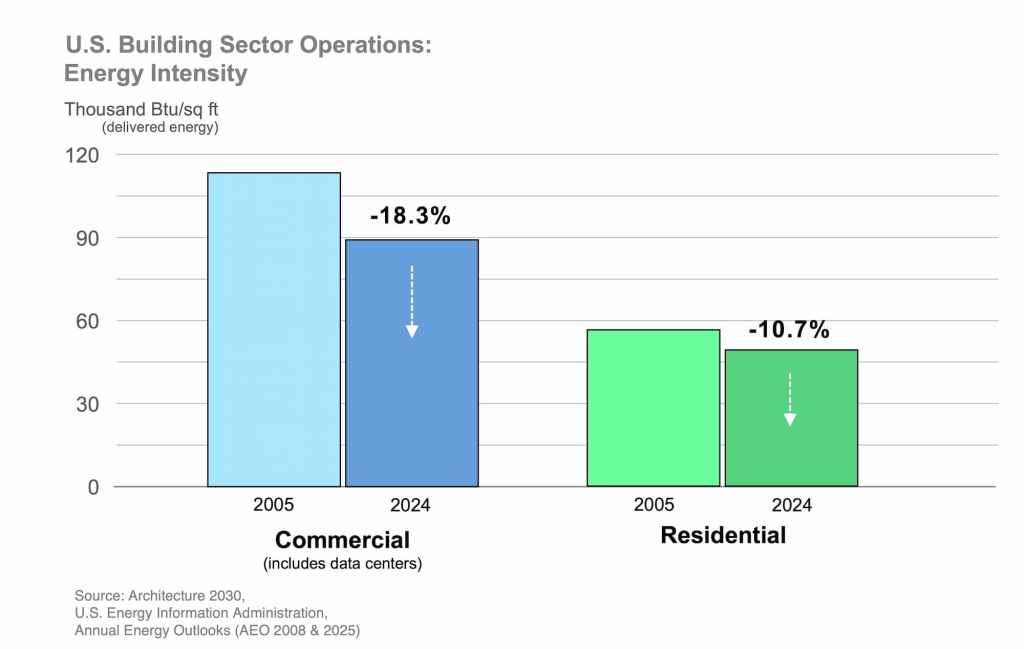

The Paradox of Growth and Decline
Looking to the future, the U.S. EIA estimates that total building sector energy consumption will continue to decline, even as hyperscale data centers expand rapidly. By 2030, electricity demand from U.S. data centers is expected to more than triple, from 25 gigawatts (GW) today to over 80 GW. Yet, according to the EIA, this surge will have a surprisingly slight impact on the building sector.
Between 2024 and 2030, total delivered electricity to all buildings, including data centers, is projected to rise by just 2.2%. Even more striking, the total energy required to generate this electricity is expected to fall by 10%.
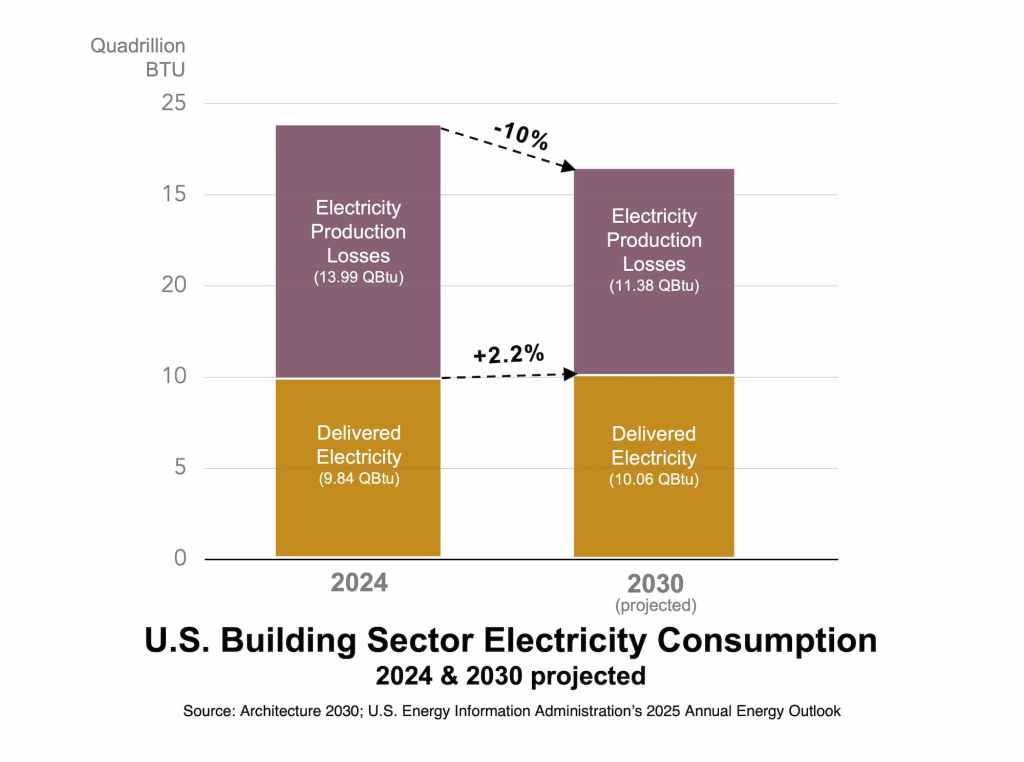
How is this possible?
These projections present a seemingly contradictory scenario where a massive buildout of data centers and new buildings results in only a slight rise in building sector delivered electricity, while the sector’s total electricity consumption drops significantly. This paradox is explained by two powerful, simultaneous trends.
First, the new demand from new buildings and data centers is almost entirely offset by deep and continuous reductions in building energy use. These efficiency gains—spanning everything from planning and building design, renovations, and incorporating passive systems, improved heating, cooling, ventilation systems, lighting, and appliances, to the adoption of the latest building energy codes and standards—drastically reduce the delivered electricity that buildings need to pull from the grid.
With about 60% of the commercial building stock constructed between 1945-1999 now requiring substantial upgrades, renovations are already outpacing new construction according to the 2022 American Institute of Architects Billings Index and building permit data. Renovating these structures not only extends their viability for decades but also requires just a fraction of the energy and carbon footprint compared to replacement.
Building renovations over the next decade are poised to increase this trend, further offsetting energy consumption from building sector and data center growth by reducing operational energy, lowering electricity demand and consumer expenditures, and avoiding the massive, embodied carbon costs of new construction.
Second, the dramatic 10% drop in total electricity consumption is a direct result of the grid’s rapid transition from inefficient generation at fossil fuel plants—which waste roughly two-thirds of their fuel energy as heat—to highly efficient renewable sources like wind, solar, and geothermal.
So, while the building sectors direct electricity use is expected to remain nearly flat, the total amount of raw fuel that utilities need to produce that electricity is falling significantly as the grid becomes cleaner and more efficient.
According to the EIA, total net electricity generation from non-CO2 emitting renewables sources grew from about 9% in 2005 to 24% by 2024. This trend is projected to accelerate, with the renewables share expected to reach 38% by 2030, with total non-CO2 emitting sources increasing to 54.8%.
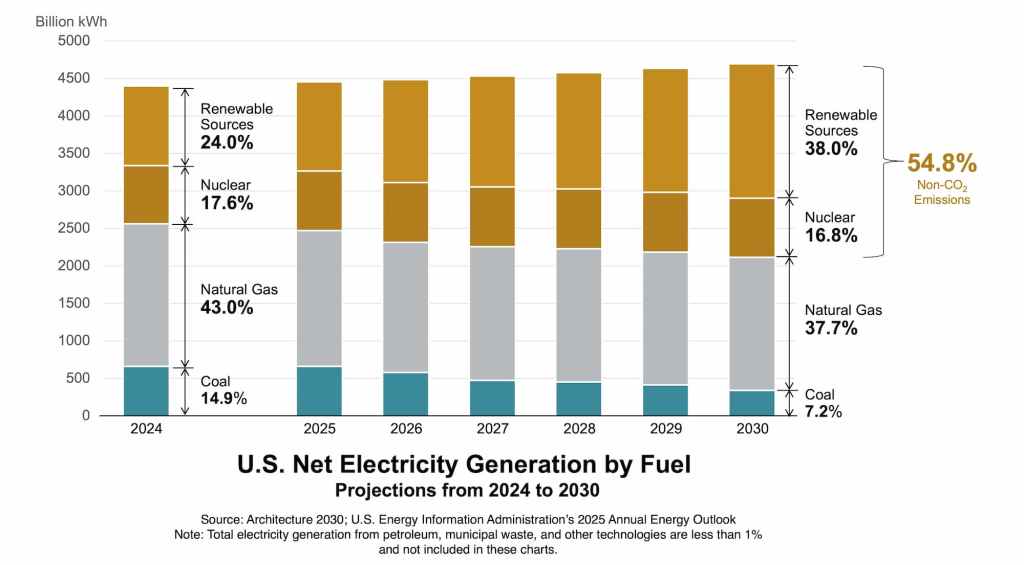
Consequently, the influence of recently passed tax laws on the building sector is expected to be muted. This resilience stems from three key factors. First, profound efficiency gains are reducing the need for new electricity. Second, the compelling economics of cheaper renewables—amplified by the urgent need to address climate disasters—continue to drive their adoption. Finally, and most critically, building design and construction practices—governed by architects, engineers, planners, design professionals, and state and local governments—are largely insulated from shifts in federal priorities.
The combined impact of building renovations, reduced building energy intensity, and inexpensive renewable energy for electricity generation has effectively offset the increased energy demands from new construction and data centers, now and in the near future.
This move toward energy-efficient, low-carbon buildings and infrastructure is mirrored by a transformative shift in the global building market as well. Fueled by design and planning, growth of smart cities, and the adoption of efficiency and renewable energy policies, the market is projected to more than double from $0.6 trillion in 2023 to a staggering $1.3 trillion by 2033.
This booming investment underscores a worldwide embrace of efficiency and low carbon design and building practices that are proving to be both highly effective and economically viable.
America’s Sacrifice Zone: The Heartland
To revitalize the coal industry, the Trump administration is ordering coal plants to stay open and is exempting nearly 70 coal-fired power plants from air pollution controls, delaying compliance with Mercury and Air Toxics Standards for at least two years, with the potential for further extensions.
This weakens limits on mercury, acid gases, carcinogenic heavy metals, and dangerous PM2.5 emissions, leaving the public to bear the costs. Existing coal plant emissions are already estimated to cause approximately 3,800 premature deaths annually, with hidden societal costs totaling up to $500 billion each year.
The accompanying map shows toxic PM2.5 pollution from coal plants across the U.S., with circle size indicating mortality impact. The largest impacts concentrate in America’s heartland, from Western Pennsylvania through the Midwest, and into Texas, with pollution spreading across the country—underscoring the widespread health risks of environmental protection rollbacks.
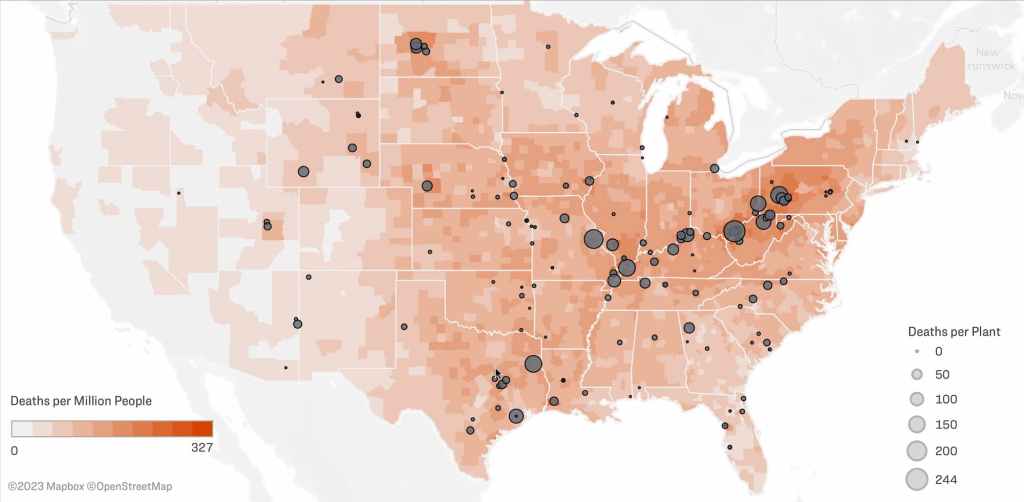
Compounding these issues, America’s heartland is grappling not only with toxic air pollution but also with unprecedented storms and precipitation patterns. These patterns are resulting in devastating floods and destruction, widely understood to be intensified by climate change, causing heavy rainfall to become even more extreme. Scientists explain that warmer air can hold more moisture, which amplifies the risk of intense rainfall and heavy downpours.
The year 2025 brought this reality into sharp focus for millions of Americans. A series of severe weather events, from deadly flooding in the heartland in February to catastrophic record-breaking floods across the Midwest and South in April and May, has created a new sense of urgency. These events, culminating in the devastating flash floods that killed over 100 people in Texas, have highlighted the immense costs of a destabilized climate.
The willingness to sacrifice public health is mirrored by a policy of intentional ignorance. As Forbes noted, one of the most effective ways to ignore reality is to stop measuring it. This attack on data is now being compounded by an attack on expertise.
The National Oceanic and Atmospheric Administration (NOAA) is not only retiring its Billion-Dollar Disasters database—one of the most reliable trendlines in climate policy, documenting nearly $3 trillion in escalating inflation-adjusted damages—but is also laying off key federal scientists and weather forecasting employees.
This pattern of dismantling both data systems and expert staff poses an immediate danger. The Department of Defense announced it will no longer provide the crucial satellite data that hurricane forecasters have relied on for decades. With fewer experts to analyze the remaining information, this will inevitably degrade forecast accuracy and further endanger lives.
The loss of these critical tools—and the experts who use them—creates dangerous blind spots. The database provided a verifiable 40-year trendline of accelerating economic damage, which policymakers, insurers, and city planners used to assess long-term risk. The satellite data is vital for immediate public safety. Dismantling the very systems and staff that measure these impacts hides the dangerous patterns and their resulting costs—both in dollars and in lives.
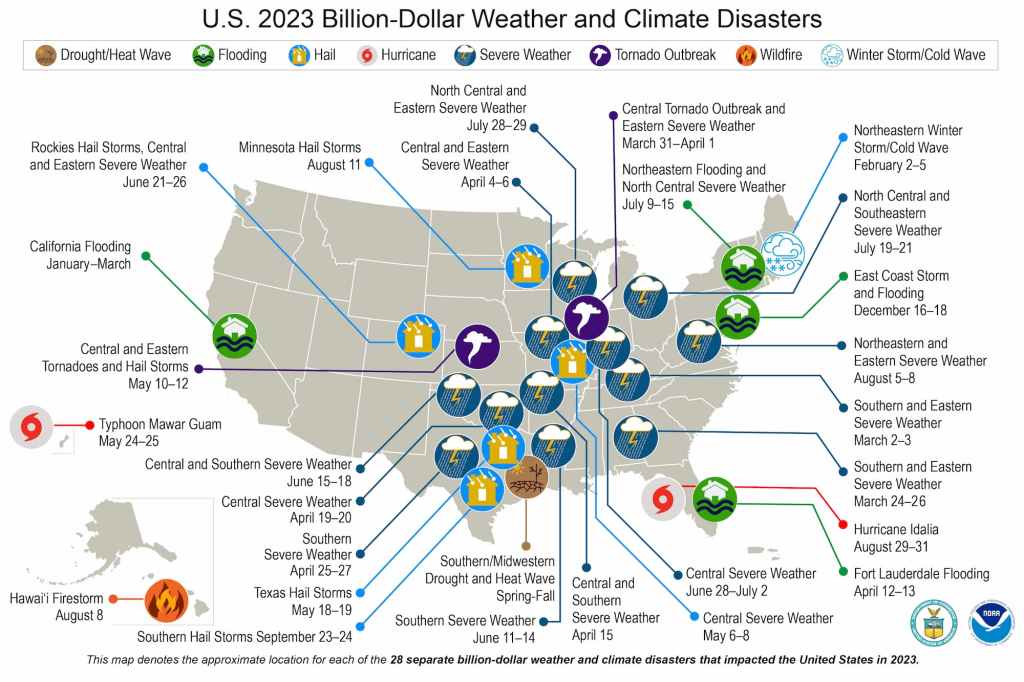
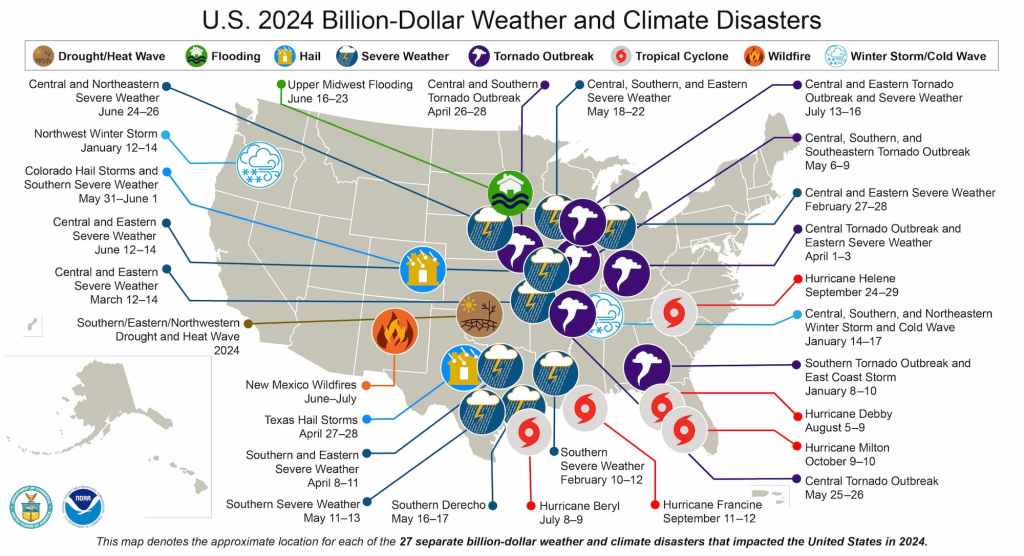
This catastrophic and costly toll to America’s heartland and coastal areas—loss of life, adverse health impacts, destroyed homes and businesses, flooded cropland, contaminated water supplies, and thousands displaced—demands critical access to scientific information, urgent building and infrastructure adaptation and upgrades, and an unwavering commitment to phasing out all remaining coal plants.
Floods in the United States have become both more frequent and more destructive, and federal legislation plays a critical role in shaping how the nation prepares for, responds to, and recovers from these disasters. Warmer air holds more moisture, which intensifies rainfall and drives catastrophic flooding across the Midwest, South, and coastal regions—events that in 2025 alone have killed hundreds and caused billions in damages (Just look at the floods in Spencer, Iowa in June 2024; in Rives, TN in Feb 2025; in Hopkinsville, Kentucky in April 2025; and Camp Mystic, Kerr County, Texas in July 2025. Yet instead of strengthening protections, recent rollbacks of clean air, clean water, and climate data programs have dismantled tools that help forecast extreme precipitation and track long-term risk.


A Win-Win Solution: Replacing Coal Plants with Data Centers and Renewables
The energy landscape in the U.S. is already undergoing a seismic shift. Aging coal-fired power plants are no longer seen as assets; instead, they are recognized as significant economic and environmental liabilities. Many facilities have surpassed their intended operational lifespans, leading to reduced efficiency, increased maintenance costs, and a higher likelihood of unexpected breakdowns.
Beyond their heavy environmental and public health burdens, extending the life of these plants requires exorbitant investments that yield diminishing returns and increase electricity costs for consumers.
The smart alternative is to retire coal plants and repurpose their sites for data centers and renewable energy installations. These sites often have existing grid interconnection infrastructure, which offers significant cost and time savings. Planning and designing energy-efficient data centers powered by on-site or locally sourced renewables is proving to be less expensive than building new fossil fuel facilities, cheaper than running existing coal plants, and much faster to construct than nuclear or other fossil fuel plants.
This strategy is a major win for public health, consumer savings, job creation, environmental quality, grid stability, and technological advancement. It can bring new economic vitality to communities historically reliant on coal and affected by plant closures by offering new job opportunities in the construction, operation, and maintenance of data centers and renewable energy facilities.
An Evidence-Based Path Forward
The notion that America (or any country) must cling to polluting energy sources out of irrational fear—sacrificing public health, economic potential, and climate resilience—is unnecessary and unconscionable in an era of escalating climate disasters.
The U.S. building sector’s quiet energy revolution powerfully demonstrates this reality, achieving a significant decrease in energy consumption and consumer costs since 2005 while accommodating massive growth, including energy-intensive data centers.
The evidence is clear: public health, and the country’s future are best served by embracing progress through design, planning, and clean energy, not by needlessly perpetuating the climate instability and health harms of the past.
Replacing coal plants with a strategic combination of data centers and/or rapidly deployable renewable energy sources, while continuing to advance the building sector and built environment’s already impressive energy reduction trajectory, is the intelligent path forward to building a more resilient and prosperous future.
It simultaneously creates high-paying jobs, reduces energy costs for consumers, attracts investment, strengthens energy independence and climate security, and provides a blueprint for other nations to achieve similar benefits.
This transition is more than just a good idea; it is the most sensible, evidence-backed plan to a cleaner, healthier, safer, and more prosperous future–a path forged by the collaboration and leadership of our design and planning communities and dedicated local governments.
